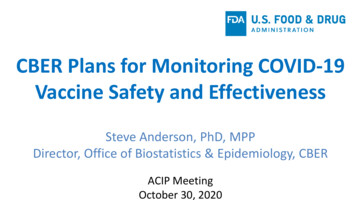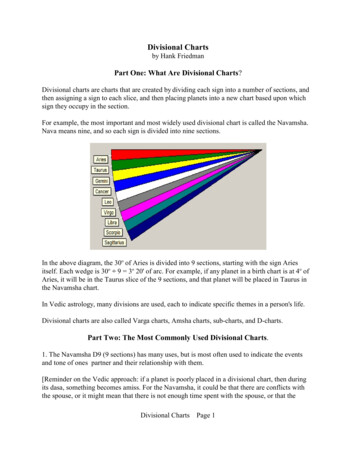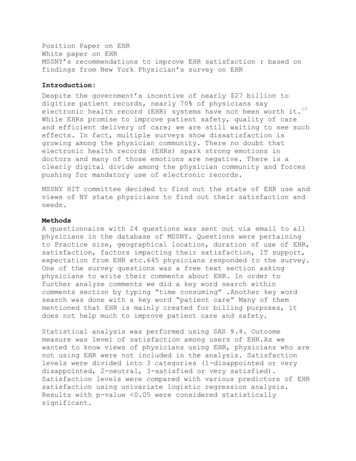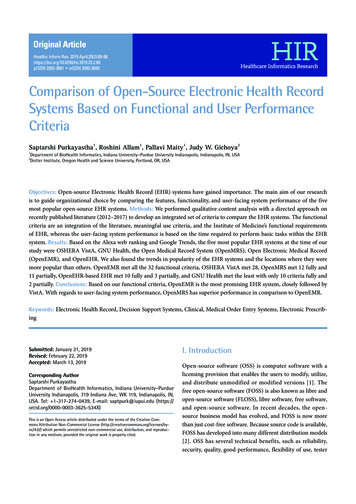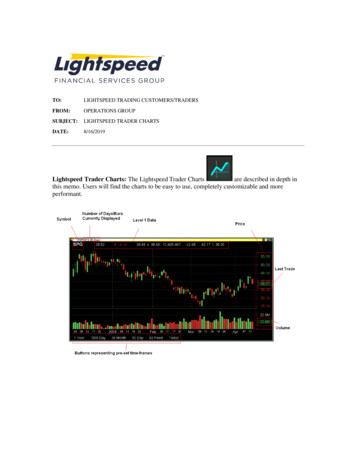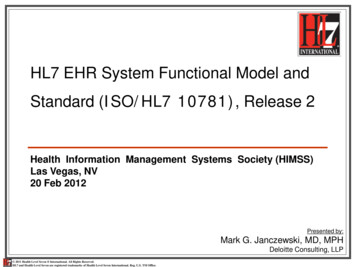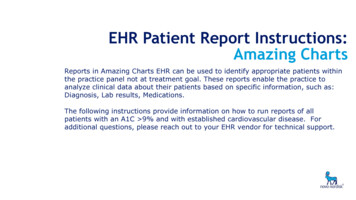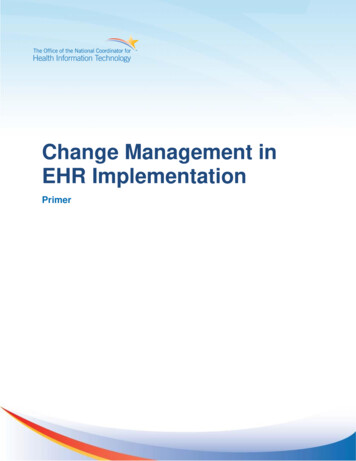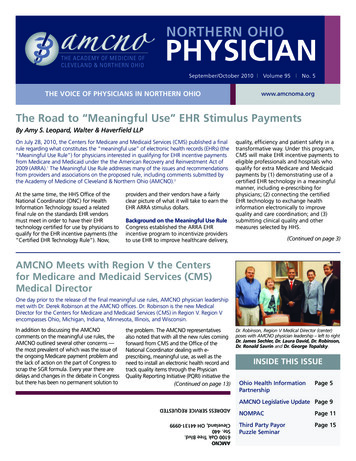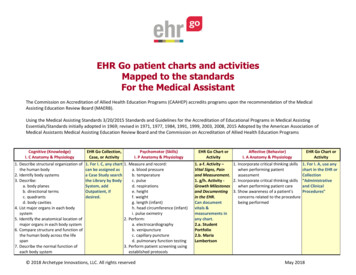
Transcription
EHR Go patient charts and activitiesMapped to the standardsFor the Medical AssistantThe Commission on Accreditation of Allied Health Education Programs (CAAHEP) accredits programs upon the recommendation of the MedicalAssisting Education Review Board (MAERB).Using the Medical Assisting Standards 3/20/2015 Standards and Guidelines for the Accreditation of Educational Programs in Medical AssistingEssentials/Standards initially adopted in 1969; revised in 1971, 1977, 1984, 1991, 1999, 2003, 2008, 2015 Adopted by the American Association ofMedical Assistants Medical Assisting Education Review Board and the Commission on Accreditation of Allied Health Education ProgramsCognitive (Knowledge)I. C Anatomy & Physiology1. Describe structural organization ofthe human body2. Identify body systems3. Describe:a. body planesb. directional termsc. quadrantsd. body cavities4. List major organs in each bodysystem5. Identify the anatomical location ofmajor organs in each body system6. Compare structure and function ofthe human body across the lifespan7. Describe the normal function ofeach body systemEHR Go Collection,Case, or ActivityPsychomotor (Skills)I. P Anatomy & Physiology1. For I. C, any chart 1. Measure and record:can be assigned asa. blood pressurea Case Study searchb. temperaturethe Library by Bodyc. pulseSystem, addd. respirationsOutpatient, ife. heightdesired.f. weightg. length (infant)h. head circumference (infant)i. pulse oximetry2. Perform:a. electrocardiographyb. venipuncturec. capillary punctured. pulmonary function testing3. Perform patient screening usingestablished protocols 2018 Archetype Innovations, LLC. All rights reservedEHR Go Chart orActivityAffective (Behavior)I. A Anatomy & Physiology1. a-f. Activity –1. Incorporate critical thinking skillsVital Signs, Painwhen performing patientand Measurement.assessment1. g/h. Activity 2. Incorporate critical thinking skillsGrowth Milestoneswhen performing patient careand Documenting 3. Show awareness of a patient’sin the EHR.concerns related to the procedureCan documentbeing performedvitals &measurements inany chart.2.a. StudentPortfolio2.b. MariaLambertsonEHR Go Chart orActivity1. For I. A, use anychart in the EHR orCollection“Administrativeand ClinicalProcedures”May 2018
8. Identify common pathology relatedto each body system:a. signsb. symptomsc. etiology9. Analyze pathology for each bodysystem including:a. diagnostic measuresb. treatment modalities10. Identify CLIA waived testsassociated with common diseases11. Identify the classifications ofmeds including:a. indications for useb. desired effectsc. side effectsd. adverse reactions12. Identify quality assurancepractices in healthcare13. List principles and steps ofprofessional/provider CPR14. Describe basic principles of firstaid as they pertain to theambulatory healthcare settingCognitive (Knowledge)II. C Applied Mathematics1. Demonstrate knowledge of basicmath computations4. Verify the rules of med admin:4.Activity a. right patientMedicationb. right medicationAdministrationc. right dosecharts 1-58.Meridith Dewietz;d. right routeActivity – PediatricGordon Lande. right timeImmunizationsf. right documentation5. Select proper sites for5. Claire Larson;administering parenteral medsMeridith Dewietz6. Administer oral meds7. Administer parenteral (excluding 7.Claire Larson;IV) medsMeridith Dewietz8. Instruct and prepare a patient for a 8. Daisha Estrada10. Daisha Estrada;procedure or a treatmentSommer Benedict 9. Assist provider with an exam9. Daisha Estrada11. Medication10. Perform a quality control measureAdministration11. Obtain specimens and perform: 11.With any chart:charts 1-5a. CLIA waived hematologyDocument resultsb. CLIA waived chemistryin Lab tab ofc. CLIA waived urinalysispatient chartd. CLIA waived immunologye. CLIA waived microbiology12. Produce up-to-date12. Use any chart ordocumentationSkills activity13. Perform first aid procedures for:a. bleedingb. diabetic coma or insulin shockc. fracturesd. seizurese. shockf. syncopeEHR Go Chart orPsychomotor (Skills)EHR Go Chart orAffective (Behavior)ActivityII. P Applied MathematicsActivityII. A Applied Mathematics1. Calculate proper dosages of1. Reassure a patient of the accuracymedication for administrationof the test results 2018 Archetype Innovations, LLC. All rights reservedMay 2018EHR Go Chart orActivity
2. Apply mathematical computationsto solve equations3. Define basic units of measurement:a. the metric systemb. the household system4. Convert among measurementsystems5. Identify abbreviations and symbolsused in calculating medicationdosages6. Analyze healthcare results as6. Nathanreported in:Holderfield;a. graphsMeridith Dewietzb. tablesCognitive (Knowledge)EHR Go Chart orIII. C Infection ControlActivity1. List major types of infectiousagents2. Describe the infection cycle:a. the infectious agentb. reservoirc. susceptible hostd. means of transmissione. portals of entryf. portals of exit3. Define the following as practicedwithin an ambulatory care setting:a. medical asepsisb. surgical asepsis4. Identify methods of controlling thegrowth of microorganisms5. Define the principles of standardprecautions6. Define PPE for:a. all body fluids, secretions andexcretions2. Differentiate between normal andabnormal test results3. Maintain lab test results using flowsheets4. Document on a growth chart4. Activity – GrowthMilestones andDocumenting in theEHRPsychomotor (Skills)III. P Infection Control1. Participate in bloodborne pathogentraining2. Select appropriate barrier/PPE3. Perform handwashing4. Prepare items for autoclaving5. Perform sterilization procedures6. Prepare a sterile field7. Perform within a sterile field8. Perform wound care9. Perform dressing change10. Demonstrate proper disposal ofbiohazardous materiala. sharpsb. regulated wastes 2018 Archetype Innovations, LLC. All rights reservedEHR Go Chart orActivityAffective (Behavior)EHR Go Chart orIII. A Infection ControlActivity1. Recognize the implications forFor III. A, use EHRfailure to comply with CDCto supportregulations in healthcare settings discussion. For ex:routine ped visits &vaccines JocelynWuMay 2018
b. bloodc. non-intact skind. mucous membranes7. Identify CDC regulations thatimpact healthcare practicesCognitive (Knowledge)IV. C Nutrition1. Describe dietary nutrients:a. carbohydratesb. fatc. proteind. mineralse. electrolytesf. vitaminsg. fiberh. water2. Define the function of dietarysupplements3. Identify special dietary needs:a. weight controlb. diabetesc. cardiovascular diseased. hypertensione. cancerf. lactose sensitivityg. gluten-freeh. food allergiesCognitive (Knowledge)V. C Concepts of EffectiveCommunication1. Identify styles and types of verbalcommunication2. Identify types of nonverbalcommunication3. Recognize barriers tocommunication7.Daisha Estrada;Jocelyn WuEHR Go Chart orPsychomotor (Skills)ActivityIV. P Nutrition1.Use EHR to1. Instruct a patient according tosupport discussion.patient’s special dietary needsFor ex:carbohydrates John JamesSheppard Sr.EHR Go Chart orActivity1.Gordan Land;DeliaGiannoppoulos;Meridith DewietzAffective (Behavior)IV. A Nutrition1. Show awareness of patient’sconcerns regarding a dietarychangeEHR Go Chart orActivityAffective (Behavior)V. A. Concepts of EffectiveCommunication1. Demonstrate:a. empathyb. active listeningc. nonverbal communication2. Demonstrate the principles of selfboundariesEHR Go Chart orActivity2.Meridith Dewietz3.a. DeliaGiannoppoulos;3.b. NathanHolderfield;3.c. Alec Allard;3.d. Gordon Land;3e. Ulfat AftabEHR Go Chart orActivityPsychomotor (Skills)EHR Go Chart orV. P. Concepts of EffectiveActivityCommunicationFor V. C, use EHR1. Use feedback techniques to obtain 1.Activity –charts to supportpatient information including:Updating Healthdiscussion. For ex:a. reflectionInformationSpanish speakingb. restatementpts Mr. and Mrs.c. clarificationDiaz 2018 Archetype Innovations, LLC. All rights reservedMay 2018
4. Identify techniques for overcomingcommunication barriers5. Recognize the elements of oralcommunication using a senderreceiver process6. Define coaching a patient as itrelates to:a. health maintenanceb. disease preventionc. compliance with treatmentd. community resourcese. adaptations relevant toindividual patient needs7. Recognize elements offundamental writing skills8. Discuss applications of electronictechnology in profession9. Identify medical terms labeling theword parts10. Define medical terms andabbreviations related to all bodysystems11. Define the principles of selfboundaries12. Define patient navigator13. Describe the role of the medicalassistant as a patient navigator14. Relate the following behaviors toprofessional communication:a. assertiveb. aggressivec. passive15. Differentiate between adaptive &non-adaptive coping mechanisms16. Differentiate between subjectiveand objective information9.Activity – EHRDocumentationProtocols2. Respond to nonverbalcommunication3. Use medical terminology correctlyand pronounced accurately tocommunicate information toproviders and patients4. Coach patients regarding:a. office policiesb. health maintenancec. disease preventiond. treatment plan5. Coach patients appropriatelyconsidering:a. cultural diversityb. developmental life stagec. communication barriers6. Demonstrate professionaltelephone techniques7. Document telephone messagesaccurately8. Compose professionalcorrespondence utilizing electronictechnology9. Develop a current list ofcommunity resources related topatients’ healthcare needs10. Facilitate referrals to communityresources in the role of a patientnavigator11. Report relevant informationconcisely and accurately3. Can beaccomplished inany chart or byusing the StudentPortfolio3. Demonstrate respect for individual 3. Ulfat Aftab; Deliadiversity including:Giannoppoulos;a. genderAnaLetecia Diazb. racec. religiond. agee. economic statusf. appearance4. Explain to a patient the rationalefor performance of a procedure6.Activity –Documenting aphone call9.Ulfat Aftab;AnaLetecia Diaz10.Ulfat Aftab;DeliaGiannoppoulos;AnaLetecia Diaz11.Use any chart15.AnaLatecia Diaz;Simon Zhou16. Use with anychart (reviewnotes) 2018 Archetype Innovations, LLC. All rights reservedMay 2018
17. Discuss the theories of:a. Maslowb. Eriksonc. Kubler-Ross18. Discuss examples of diversity:a. culturalb. socialc. ethnicCognitive (Knowledge)VI. C Administrative Functions1. Identify different types ofappointment scheduling methods2. Identify advantages anddisadvantages of the followingappointment systemsa. manualb. electronic3. Identify critical informationrequired for scheduling patientprocedures4. Define types of informationcontained in the patient’s medicalrecord5. Identify methods of organizing thepatient’s medical record based on:a. POMRb. SOMR6. Identify equipment and suppliesneeded for medical records to:a. Createb. Maintainc. Store7. Describe filing indexing rules8. Differentiate between EMR & PMS17. Albert Diaz;James T. Sheppard18. Ulfat Aftab; JayDelgado; AnaLeticiaDiaz; Simon ZhouEHR Go Chart orActivity3. Activity –Scheduling Followup Appointment4,5. Use any chartPsychomotor (Skills)EHR Go Chart orAffective (Behavior)VI. P Psychomotor FunctionsActivityVI. A Administrative Functions1. Manage appointment schedule1. Display sensitivity when managingusing established prioritiesappointments2. Schedule a patient procedure3. Create a patient’s medical record 3.Use the guide,4. Organize a patient’s medical record Registering5. File patient medical recordsPatients Using the6. Utilize an EMRStudent Portfolio7. Input patient data utilizing a7. Activity - New Ptpractice management systemRegistration8. Perform routine maintenance ofInsurance A; Newadministrative or clinicalPt RegistrationequipmentInsurance B; and9. Perform an inventory withNew Pt RegistrationdocumentationInsurance CEHR Go Chart orActivityFor VI. A, any ofthese skills can beaccomplished inany chart or usingthe StudentPortfolio.6. Use EHR tosupport discussion8. Use EHR tosupport discussion 2018 Archetype Innovations, LLC. All rights reservedMay 2018
9. Explain the purpose of routinemaintenance of administrative andclinical equipment10. List steps involved in completingan inventory11. Explain the importance of databack-up12. Explain meaningful use as itapplies to EMRCognitive (Knowledge)VII. C Basic Practice Finances1. Define the following bookkeepingterms:a. chargesb. paymentsc. accounts receivabled. accounts payablee. adjustments2. Describe banking procedures asrelated to the ambulatory caresetting3. Identify precautions for acceptingthe following types of payments:a. cashb. checkc. credit cardd. debit card4. Describe types of adjustmentsmade to patient accounts:a. NSF checkb. collection agency transactionc. credit balanced. third party5. Identify types of information in thepatient's billing recordEHR Go Chart orPsychomotor (Skills)ActivityVII. P Basic Practice FinancesFor VII. C, use the 1. Perform accounts receivableEHR to support theprocedures to patient accountsdiscussionincluding posting:(Accounts Ledger)a. chargesb. paymentsc. adjustments2. Prepare a bank deposit3. Obtain accurate patient billinginformation4. Inform a patient of financialobligations for services renderedEHR Go Chart orActivityAffective (Behavior)VII. A Basic Practice Finances1. Demonstrate professionalismwhen discussing patient's billingrecord2. Display sensitivity whenrequesting payment for servicesrenderedEHR Go Chart orActivityFor VII. A, use theEHR to support thediscussion.3.Activity – EditingPatient Information4. Use any chart5. Use any chart(Accounts Ledger) 2018 Archetype Innovations, LLC. All rights reservedMay 2018
6. Explain patient financial obligationsfor services renderedCognitive (Knowledge)EHR Go Chart orVIII. C Third Party ReimbursementActivity1. Identify:a. types of 3rd party plansb. information required to file a3rd party claimc. steps for filing a 3rd party claim2. Outline managed carerequirements for patient referral3. Describe processes for:3. Use EHR toa. verification of eligibilitysupport discussionb. precertificationc. preauthorization4. Define a patient-centered medicalhome (PCMH)5. Differentiate between fraud andabuseCognitive (Knowledge)EHR Go Chart orIX. C Procedural & Diagnostic CodingActivity1. Describe how to use the mostFor IX. C, use thecurrent procedural coding system EHR to support the2. Describe how to use the mostdiscussion.current diagnostic codingclassification system3. Describe how to use the mostcurrent HCPCS level II codingsystem4. Discuss the effects of:a. upcodingb. downcoding5. Define medical necessity as itapplies to procedural anddiagnostic codingPsychomotor (Skills)VIII. P Third Party Reimbursement1. Interpret information on aninsurance card2. Verify eligibility for servicesincluding documentation3. Obtain precertification orpreauthorization includingdocumentation4. Complete an insurance claim formEHR Go Chart orAffective (Behavior)ActivityVIII. A Third Party ReimbursementFor VIII. P, use the 1. Interact professionally with 3rdEHR to support theparty representativesdiscussion (For ex: 2. Display tactful behavior whenMary Corbet)communicating with medicalproviders regarding 3rd partyrequirements3. Show sensitivity whencommunicating with patientsregarding 3rd party requirementsPsychomotor (Skills)EHR Go Chart orIX. P Procedural & Diagnostic CodingActivity1. Perform procedural codingFor IX. P, use any2. Perform diagnostic codingchart.3. Utilize medical necessity guidelines 2018 Archetype Innovations, LLC. All rights reservedAffective (Behavior)IX. A Procedural & Diagnostic Coding1. Utilize tactful communication skillswith medical providers to ensureaccurate code selectionMay 2018EHR Go Chart orActivityEHR Go Chart orActivity
Cognitive (Knowledge)EHR Go Chart orX. C Legal ImplicationsActivity1. Differentiate between scope ofFor X. C, use thepractice and standards of care for EHR to support themedical assistantsdiscussion.2. Compare and contrast providerand medical assistant roles interms of standard of care3. Describe components of HIPAA4. Summarize Patient Bill of Rights5. Discuss licensure and certificationas applied to healthcare providers6. Compare criminal & civil law asthey apply to the practicing MA7. Define:a. negligenceb. malpracticec. statute of limitationsd. Good Samaritan Act(s)e. Uniform Anatomical Gift Actf. living will/advanced directivesg. medical DPOAh. PSDAi. risk management8. Describe the following types ofinsurance:a. liabilityb. professional (malpractice)c. personal injury9. List and discuss legal and illegalapplicant interview questions10. Identify:a. HITECH Actb. GINA of 2008c. ADAAAPsychomotor (Skills)X. P Legal Implications1. Locate a state’s legal scope ofpractice for medical assistants2. Apply HIPAA rules in regard to:a. privacyb. release of information3. Document patient care accuratelyin the medical record4. Apply the Patient’s Bill of Rights asit relates to:a. choice of treatmentb. consent for treatmentc. refusal of treatment5. Perform compliance reportingbased on public health statutes6. Report an illegal activity in thehealthcare setting following properprotocol7. Complete an incident reportrelated to an error in patient care 2018 Archetype Innovations, LLC. All rights reservedEHR Go Chart orActivityAffective (Behaviors)EHR Go Chart orX. A Legal ImplicationsActivity1. Demonstrate sensitivity to patient For X. A, use therightsEHR to support the2. Protect the integrity of thediscussion.medical record3.Student Portfolio;Use any chart5.Daisha Estrada;Jay Delgado (if anytests return )May 2018
11. Describe the process incompliance reporting:a. unsafe activitiesb. errors in patient carec. conflicts of interestd. incident reports12. Describe compliance with publichealth statutes:a. communicable diseasesb. abuse, neglect & exploitationc. wounds of violence13. Define the following terms:a. informed consentb. implied consentc. expressed consentd. patient incompetencee. emancipated minorf. mature minorg. subpoena duces tecumh. respondent superiori. res ipsa loquitorj. locum tenensk. defendant-plaintiffl. depositionm. arbitration-mediationn. Good Samaritan lawsCognitive (Knowledge)XI. C Ethical Considerations1. Define:a. ethicsb. morals2. Differentiate between personaland professional ethics3. Identify the effect of personalmorals on professionalperformanceEHR Go Chart orActivityPsychomotor (Skills)XI. P Ethical Considerations1. Develop a plan for separation ofpersonal and professional ethics2. Demonstrate appropriateresponse(s) to ethical issues 2018 Archetype Innovations, LLC. All rights reservedEHR Go Chart orActivityAffective (Behavior)XI. A Ethical Considerations1. Recognize the impact personalethics and morals have on thedelivery of healthcareMay 2018EHR Go Chart orActivity
Cognitive (Knowledge)XII. C Protective Practices1. Identify:a. safety signsb. symbolsc. labels2. Identify safety techniques that canbe used in responding to accidentalexposure to:a. bloodb. other body fluidsc. needle sticksd. chemicals3. Discuss fire safety issues in anambulatory healthcareenvironment4. Describe fundamental principlesfor evacuation of a healthcaresetting5. Describe the purpose of SDS in ahealthcare setting6. Discuss protocols for disposal ofbiological chemical materials7. Identify principles of:a. body mechanicsb. ergonomics8. Identify critical elements of anemergency plan for response to anatural disaster or otheremergencyEHR Go Chart orActivityPsychomotor (Skills)XII. P Protective Practices1. Comply with:a. safety signsb. symbolsc. labels2. Demonstrate proper use of:a. eyewash equipmentb. fire extinguishersc. sharps disposal containers3. Use proper body mechanics4. Participate in a mock exposureevent with documentation ofspecific steps5. Evaluate the work environment toidentify unsafe working conditions 2018 Archetype Innovations, LLC. All rights reservedEHR Go Chart orActivityAffective (Behavior)XII. A Protective Practices1. Recognize the physical andemotional effects on personsinvolved in an emergencysituation2. Demonstrate self-awareness inresponding to an emergencysituationMay 2018EHR Go Chart orActivity
Medical Assisting EHR Go Collections and activities:Introduction to Electronic Health Records: Building a foundationEHR OrientationAn orientation activity to be completed by all new users of Go!Tools and Resources in EHR GoAn introduction to the tools and resources available in the EHR Go educational electronic health record.EHR Documentation StandardsAn introduction to documentation standards in the electronic health record.The Power of the EHRAn introduction to what the EHR can do and how it can be used in improving healthcare outcomes.Evidence Based Practice (VTE)An introduction to health information management for students who will be caring for patients in the clinical setting.Introduction to Privacy and SecurityAn introduction to privacy, security, confidentiality and cybersecurity in the EHR.Introductory EvaluationThis activity can serve as a quiz or exam, requiring students to demonstrate the necessary skills and understanding to access an EHR system andidentify and interpret patient data.Introduction to Chart DeficienciesAn introduction to auditing a chart for documentation deficiencies. 2018 Archetype Innovations, LLC. All rights reservedMay 2018
Evidence Based Practice Clinical Audit T2DMAn introduction to clinical guidelines and the clinical audit process of evaluating for evidence-based practice.Health Information Terminology (AS)An introduction to health information terminology for the beginning EHR student user.Release of Information (AS)An introduction to the privacy and security safeguards provided by HIPAA and how its protection relates to release of patient health information.Retrieval of Data (AS)An introduction to data retrieval within the electronic health record.Administrative and Clinical Procedures: Skills activities for medical officeRegistration and Insurance: Adding and updating patient registration, including insurance, and checking in patientsNew Patient Registration AThis activity provides practice with registering a new patient.New Patient Registration BThis activity provides practice with registering a new patient.New Patient Registration CThis activity provides practice with registering a new patient.Checking in a PatientThis activity provides practice with checking in a patient for an appointment.Updating Patient RegistrationThis activity provides practice with updating changes to a patient's registration information.Editing Patient InformationThis activity provides practice with updating a patient's EHR to reflect changes in demographic and insurance information. 2018 Archetype Innovations, LLC. All rights reservedMay 2018
Documenting a Patient Phone CallThis activity provides practice with documenting a phone call with a patient in the patient's EHR.Outpatient EncounterThis activity provides practice with completing an outpatient encounter, including registration and insurance, encounter entry, and claimsubmission.Scheduling: Scheduling new and follow-up appointmentsNew Patient Registration and SchedulingThis activity provides practice with registering a new patient and scheduling a first appointment.Scheduling a Follow-up AppointmentThis activity provides practice with scheduling a follow-up appointment for an existing patient.Claims and Ledgers: Managing claims, billing and patient ledgerCreating a ClaimThis activity provides practice with creating and submitting a claim for payment by a patient's insurance company.Coding an Outpatient ClaimThis activity provides practice with coding an outpatient claim.Posting Payments and AdjustmentsThis activity provides practice with using an Explanation of Benefits (EOB) to post payments and adjustments to the patient ledger.Clinical Procedures: Managing clinical aspects of a medical officeData EntryThis activity provides practice of basic data entry and documentation skills in the EHR. 2018 Archetype Innovations, LLC. All rights reservedMay 2018
Adding OrdersThis activity provides practice with entering patient care and medication orders in a patient's EHR.Medical MathThis activity provides practice with calculating conversions and dosages commonly found in the healthcare field.Growth Milestones and Documenting in the EHRThis activity provides practice with plotting and documenting a pediatric patient's growth.Vital Signs, Pain and MeasurementsThis activity provides practice with obtaining vital signs, pain assessment and measurements from classmates or volunteers and documenting thedata collected.Pediatric ImmunizationsThis activity provides practice with immunizations and health maintenance of the pediatric patient.Updating Health InformationThis activity provides practice with updating health information in a patient’s EHR as the patient is waiting to be seen by a provider.Putting it all together: Combining clinical and administrative aspects of careRegistering a Patient and Adding OrdersThis activity provides practice with registering a new patient in the system and entering orders in the patient's EHR.New Patient Registration, Exam and BillingThis activity may be used as a final project. Students are responsible for development of the patient chart, registration. Students will alsodocument care, medication administration, prescription order processing, and the coding and filing of claims.Checkouts and DischargesUlfat AftabWithdrawal of life-saving treatments: Exam Room 2018 Archetype Innovations, LLC. All rights reservedMay 2018
Meridith DeweitzNew diagnosis B-12 deficiency: Lab/Procedure UnitOmar BashirChronic pain clinic visit: Exam RoomEdgar CashSleep study: Lab/Procedure UnitAlbert Angelico DiazOne month well-child visit: Exam RoomAnaLeticia DiazPost-partum depression, non-English speaker: Exam RoomAngel Flaco DiazNew asthma: Lab/Procedure UnitDaisha EstradaSTD: Lab/Procedure UnitDelia GiannoppoulosPre-bariatric surgery evaluation and counseling: Exam RoomNathan HolderfieldHeart failure with multiple chronic health problems: Exam RoomClaire LarsenMigraine headache with in-office Imitrex administration: Lab/Procedure UnitAnna MerrittSmoking cessation with Chantix: Exam Room 2018 Archetype Innovations, LLC. All rights reservedMay 2018
Jocelyn WuNine-month well-child visit: Exam RoomJacy Sky RedbirdAcute Pancreatitis discharge: Medical-Surgical UnitOscar SanchezNon-cardiac chest pain discharge: Emergency Room 2018 Archetype Innovations, LLC. All rights reservedMay 2018
EHR Go Chart or Activity Psychomotor (Skills) IV. P Nutrition EHR Go Chart or Activity Affective (Behavior) IV. A Nutrition EHR Go Chart or Activity 1. Describe dietary nutrients: a. carbohydrates b. fat c. protein d. minerals e. electrolytes f. vitamins g. fiber h. water 2. Define the function of dietary supplements 3. Identify special dietary .
